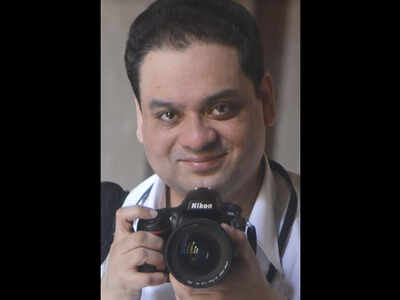
On the recent controversy over colour versus black-and-white in the context of a Ray film, TOI talks to documentary filmmaker Anirban Mitra, who has made the award-winning docu-feature on Ray’s bio-photographer Nemai Ghosh, and tries to find out some of the nuances of these two mediums and what Satyajit Ray and Ghosh thought about BW and colour.
Q: So what’s your take on restoration of old films to digital?
A: Restoration is extremely important and welcome. And we should be able to see analogue films on HD digital format. However, I strongly feel, that, in the process - no film, should be later altered in any way from its original form. Restoration has strict guiding principles and the job is supposed to bring back the undiminished state -- which the director or artist had originally created. For example, in motion-picture film restoration, it calls for retaining the film grains, the tonal quality, aspect ratio and so on. I see a lot of 4:3 format films cropped to widescreen while making digital versions. It’s quite irresponsible and horrifying. The frames get impacted in their aesthetics.
Q: Do you believe in adding new dimensions while restoration?
A: No, certainly not. Restoration is not a new creation, it is a return to the original, may be adapted for technical compatability, but that’s it. Today, we generally need to have a digital file to play a cinema in portable format, so we adapt a film-reel on digital. And, preferably also restore it to bring back the faded glory. Any change(s) even if they supposedly “improve” things, must be avoided. Every creation has an imprint of the timeline of its creation. It’s sensible to preserve that.
Q: About choosing the canvas – black and white (B/W) or colour?
A: It solely depends on the subject. Earlier, there were certain norms and conventions in Hollywood that Thrillers, hard-edged films will be in B/W, Adventures and Musicals in colour. But the best thing is to decide based on the theme and subject. It’s a maker’s call. Same for still-photography. And in stills, you choose the palette by the composition – which shot looks best in BW or Colour. In digital, you can switch. In film-photography, it was rather expensive to exert that option.
Q: And your favourite?
A: Both. But, again, as I said, I would be very careful when and why I am using one of them.
Q: Do you think B/W has its own charm and language in art?
A: Well, of course! It indeed has. It is a different kind of experience and sophisticated form where you delve deeper beneath the surface and look at finer things. I can be loosely compare it with dress and the mind- I mean if colour is the dress of a person, then B/W is the mind or heart (laughs). See, you do a pencil sketch in BW. It has its own appeal. It is a vast topic, the matter of monochrome.
Q: And what about colour?
A: See, colour is a very powerful element in Art. Hence it must be used very judiciously. For example, as we know, in India, red has a special significance for ladies and in Bengal, the red-bordered sari. You need colour to depict these. And these things convey important things. This is one example, one colour. When you consider multiple colours or a whole canvas, it becomes very complex. I remember I read quite early on in a Kodak Photography book of the 1950s, a topic of : “Colourful Vs Good Colour”. What they meant, and rightly so is that how tastefully we can use colours.
Q: What was Nemai Ghosh’s take on B/W Vs Colour?
A: He always used to say – ‘Black and white has so many hues’. And that is so true. Most of his best photographs are all in B/W, his favourite. That was by a very conscious choice. And when he used colour, you will feel that picture cannot be imagined without colour. So, the artistic discretion he used was very accurate on where to use colour. But during film days, sometimes you didn’t have the choice – may be, the photog had only one kind of film stock at disposal while shooting.
Q: Have you ever come across Ray’s comment about comparing these two mediums?
A: Oh, yes. Several of them, actually. Right now, I can remember he wrote, and I quote : “One does not imagine ‘Aparajito’ in colour. Benaras would be so gorgeous with pretty colours that the whole mood would be destroyed. The director should have the freedom to switch from black and white to colour”. So, that was that. And, remember, he had shot “Kanchenjunga” in colour, in 1962, but many of the following films in B/W. This means he was making a very definite choice of the medium and not necessarily because of budget.
And, on the use of colour, Ray on his film ‘Asani Sanket’, had said – “...nature remained beautiful and bountiful when poor people were dying for food, and this is the reason why I made the film in colour”. He meant that he wanted to establish the contrast and tragedy.
Q: Guess even within BW and Colour, there are nuances in each?
A: Absolutely. Even within BW, there are tonal variations. There is something called “grey-scale”, mid tones, the extent or intensity of black, the brightness of whites, high-key and low-key. There are a whole lot of things within BW. And, “tinted” is basically having a single colour hue. Or the once sepia tone. In colour, it is even more complex. In those days, there was that famous “technicolor” look in films. Which one could easily identify. Actually, the use of colour in cinematography is a matter of great depth and details. And even in still-photography, it is. In any visual art form, if you ask me.
Q: Any word on the recent developments?
A: It is understandable that people have a great affinity for Ray’s works, and they romance around his creations. However, I feel any experiment – preferably be confined to the personal sphere. Even for argument’s sake, if one says, a B/W film can be “perfectly coloured”, still it must not be done. It’s like adding “jhankar beats” to an already orchestrated and recorded song. Only a director himself /herself can supervise or authorize any changes to his or her handiwork. But even then, it will come under public scrutiny and evoke comparison with the original version.
(Anirban Mitra is a photographer turned film-maker with an award-winning docu-feature on Nemai Ghosh and Satyajit Ray - who have left an indelible influence on his artistic sense and sensibilities. Anirban’s photography narratives have been published as books, exhibited solo at premier galleries in Calcutta and London and are part of important institutions and permanent collections. He had extensively worked both in the analogue (film) and digital medium).
Q: So what’s your take on restoration of old films to digital?
A: Restoration is extremely important and welcome. And we should be able to see analogue films on HD digital format. However, I strongly feel, that, in the process - no film, should be later altered in any way from its original form. Restoration has strict guiding principles and the job is supposed to bring back the undiminished state -- which the director or artist had originally created. For example, in motion-picture film restoration, it calls for retaining the film grains, the tonal quality, aspect ratio and so on. I see a lot of 4:3 format films cropped to widescreen while making digital versions. It’s quite irresponsible and horrifying. The frames get impacted in their aesthetics.
Q: Do you believe in adding new dimensions while restoration?
A: No, certainly not. Restoration is not a new creation, it is a return to the original, may be adapted for technical compatability, but that’s it. Today, we generally need to have a digital file to play a cinema in portable format, so we adapt a film-reel on digital. And, preferably also restore it to bring back the faded glory. Any change(s) even if they supposedly “improve” things, must be avoided. Every creation has an imprint of the timeline of its creation. It’s sensible to preserve that.
Q: About choosing the canvas – black and white (B/W) or colour?
A: It solely depends on the subject. Earlier, there were certain norms and conventions in Hollywood that Thrillers, hard-edged films will be in B/W, Adventures and Musicals in colour. But the best thing is to decide based on the theme and subject. It’s a maker’s call. Same for still-photography. And in stills, you choose the palette by the composition – which shot looks best in BW or Colour. In digital, you can switch. In film-photography, it was rather expensive to exert that option.
Q: And your favourite?
A: Both. But, again, as I said, I would be very careful when and why I am using one of them.
Q: Do you think B/W has its own charm and language in art?
A: Well, of course! It indeed has. It is a different kind of experience and sophisticated form where you delve deeper beneath the surface and look at finer things. I can be loosely compare it with dress and the mind- I mean if colour is the dress of a person, then B/W is the mind or heart (laughs). See, you do a pencil sketch in BW. It has its own appeal. It is a vast topic, the matter of monochrome.
Q: And what about colour?
A: See, colour is a very powerful element in Art. Hence it must be used very judiciously. For example, as we know, in India, red has a special significance for ladies and in Bengal, the red-bordered sari. You need colour to depict these. And these things convey important things. This is one example, one colour. When you consider multiple colours or a whole canvas, it becomes very complex. I remember I read quite early on in a Kodak Photography book of the 1950s, a topic of : “Colourful Vs Good Colour”. What they meant, and rightly so is that how tastefully we can use colours.
Q: What was Nemai Ghosh’s take on B/W Vs Colour?
A: He always used to say – ‘Black and white has so many hues’. And that is so true. Most of his best photographs are all in B/W, his favourite. That was by a very conscious choice. And when he used colour, you will feel that picture cannot be imagined without colour. So, the artistic discretion he used was very accurate on where to use colour. But during film days, sometimes you didn’t have the choice – may be, the photog had only one kind of film stock at disposal while shooting.
Q: Have you ever come across Ray’s comment about comparing these two mediums?
A: Oh, yes. Several of them, actually. Right now, I can remember he wrote, and I quote : “One does not imagine ‘Aparajito’ in colour. Benaras would be so gorgeous with pretty colours that the whole mood would be destroyed. The director should have the freedom to switch from black and white to colour”. So, that was that. And, remember, he had shot “Kanchenjunga” in colour, in 1962, but many of the following films in B/W. This means he was making a very definite choice of the medium and not necessarily because of budget.
And, on the use of colour, Ray on his film ‘Asani Sanket’, had said – “...nature remained beautiful and bountiful when poor people were dying for food, and this is the reason why I made the film in colour”. He meant that he wanted to establish the contrast and tragedy.
Q: Guess even within BW and Colour, there are nuances in each?
A: Absolutely. Even within BW, there are tonal variations. There is something called “grey-scale”, mid tones, the extent or intensity of black, the brightness of whites, high-key and low-key. There are a whole lot of things within BW. And, “tinted” is basically having a single colour hue. Or the once sepia tone. In colour, it is even more complex. In those days, there was that famous “technicolor” look in films. Which one could easily identify. Actually, the use of colour in cinematography is a matter of great depth and details. And even in still-photography, it is. In any visual art form, if you ask me.
Q: Any word on the recent developments?
A: It is understandable that people have a great affinity for Ray’s works, and they romance around his creations. However, I feel any experiment – preferably be confined to the personal sphere. Even for argument’s sake, if one says, a B/W film can be “perfectly coloured”, still it must not be done. It’s like adding “jhankar beats” to an already orchestrated and recorded song. Only a director himself /herself can supervise or authorize any changes to his or her handiwork. But even then, it will come under public scrutiny and evoke comparison with the original version.
(Anirban Mitra is a photographer turned film-maker with an award-winning docu-feature on Nemai Ghosh and Satyajit Ray - who have left an indelible influence on his artistic sense and sensibilities. Anirban’s photography narratives have been published as books, exhibited solo at premier galleries in Calcutta and London and are part of important institutions and permanent collections. He had extensively worked both in the analogue (film) and digital medium).

Coronavirus outbreak
Trending Topics
LATEST VIDEOS
City
 On cam: Leopard rescued from well in Gujarat
On cam: Leopard rescued from well in Gujarat  Covid-19: 30,000 more cases expected in Delhi in next 12-15 days, says Satyendar Jain
Covid-19: 30,000 more cases expected in Delhi in next 12-15 days, says Satyendar Jain  Jyotiraditya Scindia and his mother test positive for Covid-19, admitted to Delhi hospital
Jyotiraditya Scindia and his mother test positive for Covid-19, admitted to Delhi hospital  Umar Khalid's aide Khalid Saifi taken under police custody for his role in Delhi anti-Hindu riots
Umar Khalid's aide Khalid Saifi taken under police custody for his role in Delhi anti-Hindu riots
More from TOI
Navbharat Times
Featured Today in Travel
Get the app





